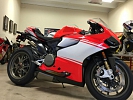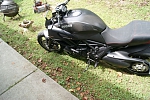Poetry in motion, Carbon, magnesium rims, collector bike, not Ducati, low miles
2000 MV Agusta F4 750 Serie Oro #254/300
| Price: | US $23,750.00 |
| Item location: | Greenwich, Connecticut, United States |
| Make: | MV Agusta |
| Model: | F4 750 Serie Oro #254/300 |
| SubModel: | Serie Oro |
| Year: | 2000 |
| Mileage: | 3,548 |
| VIN: | ZCGF400AAXV000254 |
| Color: | Red |
| Engine size: | 750 |
| Vehicle Title: | Clear |
| Contact seller: | Contact form |
2000 MV Agusta F4 Serie Oro. recent service includes fluids changed. gas lines ( in and out of tank ) changed. new Michelin Power 2CT (less than 200 miles). stored indoors in temp and humidity controlled environment. started regularly and stored with stabiliser. This is the first completely hand built reincarnation of the most famous motorcycle brand with only 20 making it stateside. thats less than1 per state so don't expect to see any on the road. Carbon fiber everything including tank. air intakes. front fender and all cowls. underside of lower cowl is a little scuffed/crack and is repairable but cannot be seen unless you take it off the bike. Further weight saving through the use of magnesium parts including rims. engine mount side plates. swingarm. and lower triple clamp! The symphony that comes from the 4 under seat organ pipes is spectacular! Comes with bike cover. rear stand. 2keys. owners manual and original brochure. There has surely never before been a motorcycle whose apparently ordinary technical specification liquid-cooled. 750cc dohc 16-valve inline four hid so much innovation. Almost every significant component of the F4 has been freshly created by Cagiva. mostly at the CRC (Cagiva Research Centre) design studio in San Marino. headed by Massimo Tamburini and his right-hand man Massimo Parenti. Only the engine was developed at Cagiva's Varese base; and the powerplant. too. is unconventional although less so than originally planned. The 749cc unit. very oversquare at 73. 8 x 43. 8mm. features the radial four-valves-per-cylinder layout drawn up more than ten years ago. in collaboration with engineers from Ferrari. Early progress was slow. but accelerated in 1994. when Claudio Castiglioni took the painful decision to scrap Cagiva's 500cc GP team (after John Kocinski had just finished third in the world championship) in order to concentrate on the F4 project. The GP engineers were put to work on the four-stroke motor and completely redesigned it. abandoning the original design of offset cylinders (two forward and two back. reducing width) and forward-facing intake system. The early prototype's radial valves. operated directly (via bucket-and-shim adjusters) by the specially shaped camshafts. were retained. as their performance benefit was found to justify the additional complexity and cost. With radial valves the gas flow shape is much better power is good and the torque curve is very favourable. says Andrea Goggi. the youthful former Cagiva 500cc racing engineer who headed the development team. The original motor's removable cassette gearbox was also kept; alternative ratios will be produced for racing. Following the F4's unveiling 18 months ago. the delay in starting production was caused largely by the need to make sure that every component supplier was able to deliver reliably at the quality required (some parts were rejected several times). But the extra year has also been useful for further engine testing. Besides performance. our main goal has been reliability. says Goggi. That is absolutely essential. The Weber-Marelli fuel-injection system has also benefited from continued development. We have spent a lot of time with the fuel-injection. making sure the transition from closed to open throttle is very smooth. Goggi says. Tamburini himself designed the 4-2-1-2-4 pipe exhaust system. which ends in that striking under-seat quartet of silencers. after dismantling and rebuilding the exhaust of Claudio Castiglioni's Ferrari F40 to check some ideas. Tamburini's involvement ensured that engine details such as the clutch cover were specially designed. in conjunction with the fairing. for minimum width. The maestro's frame is notable not just for its combination of chrome-molybdenum steel tubes and cast magnesium (aluminium on the F4S) swing-arm pivot sections. but also for the way that the front and rear sections can be unbolted for rapid access to the motor a feature that Bimota co-founder Tamburini introduced on that firm's SB2 in 1977. The rear subframe is small-diameter aluminium tube. If any one component sums-up the Serie Oro it's perhaps the swing-arm. The subject of a university thesis. it was designed using computerised stress analysis. looks totally gorgeous. and when cast in magnesium weighs just 3kg. The F4S's aluminium version is 50 per cent heavier.
Also published at eBay.com




